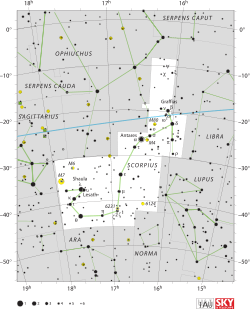Pi Scorpii

| |
| Observation data Epoch J2000 Equinox J2000 | |
|---|---|
| Constellation | Scorpius |
| Right ascension | 15h 58m 51.11324s[1] |
| Declination | –26° 06′ 50.7886″[1] |
| Apparent magnitude (V) | 2.890[2] |
| Characteristics | |
| Spectral type | B1 V + B2 V[3] |
| U−B color index | –0.918[2] |
| B−V color index | –0.187[2] |
| Variable type | Eclipsing binary |
| Astrometry | |
| Radial velocity (Rv) | –3[4] km/s |
| Proper motion (μ) | RA: –11.42[1] mas/yr Dec.: –26.83[1] mas/yr |
| Parallax (π) | 5.57 ± 0.64[1] mas |
| Distance | approx. 590 ly (approx. 180 pc) |
| Orbit[5] | |
| Period (P) | 1.570103 ± 0.000005 days[6] |
| Semi-major axis (a) | About 0.07 AU |
| Eccentricity (e) | 0.0 |
| Inclination (i) | About 42° |
| Semi-amplitude (K1) (primary) | 124.1 ± 1.5 km/s |
| Semi-amplitude (K2) (secondary) | 196.1 ± 1.8 km/s |
| Details | |
| π Sco A | |
| Mass | 12.5 ± 0.6[7] M☉ |
| Radius | 5[5] R☉ |
| Luminosity | 21,900[8] L☉ |
| Temperature | 25,230[8] K |
| Rotation | 100[8] |
| Rotational velocity (v sin i) | 108[5] km/s |
| Age | 15.4 ± 0.6,[7] 12-14[8] Myr |
| π Sco B | |
| Radius | 4[5] R☉ |
| Rotational velocity (v sin i) | 87[5] km/s |
| Other designations | |
Pi Scorpii is a triple star[9] system in the southern constellation Scorpius. With a combined apparent magnitude of 2.9,[2] it can be easily seen with the naked eye. Parallax measurements yield an estimated distance of around 590 light-years (180 parsecs) from the Earth.[2]
The name Pi Scorpii was assigned to this star by the German astronomer Johann Bayer in 1603. In 1712, it received the catalogue identifier 6 Scorpii with the publication of the star catalogue of English astronomer John Flamsteed. The binary nature of this star remained unknown until 1899, when it was announced by American astronomer Edward Charles Pickering. Two years later, an orbital period of 1.571 days was found by American astronomer Solon Irving Bailey, but it would not be until 1927 that the orbit of this spectroscopic binary was determined by Russian astronomer Otto Struve and American astrophysicist Christian T. Elvey.[5]
The main components of this system form an eclipsing binary of the Beta Lyrae type.[10] Both its members are hot, B-type main sequence stars with a blue-white hue. They display an ellipsoidal variation of 0.03 in magnitude.[6] The two stars are rotating rapidly, with projected rotational velocities of 108 and 87 km s−1, respectively.[5] Their orbital period is 1.57 days and they are separated by an estimated distance of only 15 solar radii along a circular orbit.[5] The binary system is orbited by a smaller, more distant companion, which has an apparent magnitude of +12.2. This component is separated from the pair by 50 arcseconds, putting it at least 7000 Astronomical Units away.
The Pi Scorpii system is a kinematic member of the Upper Scorpius subgroup of the Scorpius-Centaurus Association, a group of thousands of young stars with mean age 11 million years at distance 470 light years (145 parsecs).[8] A recent analysis[8] of the HR diagram position for the primary star Pi Scorpii A estimates its effective temperature to be 25,230 Kelvin with a luminosity of 21,900 Suns, consistent with an isochronal age of 12-14 million years and an estimated mass of 12-13 solar masses.
References
- 1 2 3 4 5 van Leeuwen, F. (November 2007), "Validation of the new Hipparcos reduction", Astronomy and Astrophysics, 474 (2): 653–664, arXiv:0708.1752
 , Bibcode:2007A&A...474..653V, doi:10.1051/0004-6361:20078357
, Bibcode:2007A&A...474..653V, doi:10.1051/0004-6361:20078357 - 1 2 3 4 5 Gutierrez-Moreno, Adelina; Moreno, Hugo (June 1968), "A photometric investigation of the Scorpio-Centaurus association", Astrophysical Journal Supplement, 15: 459, Bibcode:1968ApJS...15..459G, doi:10.1086/190168
- ↑ Houk, Nancy; Smith-Moore, M. (1979), Michigan catalogue of two-dimensional spectral types for the HD stars, 1, Ann Arbor, Michigan: Dept. of Astronomy, University of Michigan, Bibcode:1978mcts.book.....H
- ↑ Evans, D. S. (June 20–24, 1966), "The Revision of the General Catalogue of Radial Velocities", in Batten, Alan Henry; Heard, John Frederick, Determination of Radial Velocities and their Applications, Proceedings from IAU Symposium no. 30, University of Toronto: International Astronomical Union, Bibcode:1967IAUS...30...57E
- 1 2 3 4 5 6 7 8 Stickland, D. J.; et al. (December 1996), "Spectroscopic binary orbits from ultraviolet radial velocities Paper 23: Pi Scorpii (HD 143018)", The Observatory, 116: 387–391, Bibcode:1996Obs...116..387S
- 1 2 Shobbrook, R. R. (December 2005), "Photometry of 20 eclipsing and ellipsoidal binary systems", The Journal of Astronomical Data, 11: 1–17, Bibcode:2005JAD....11....7S
- 1 2 Tetzlaff, N.; Neuhäuser, R.; Hohle, M. M. (January 2011), "A catalogue of young runaway Hipparcos stars within 3 kpc from the Sun", Monthly Notices of the Royal Astronomical Society, 410 (1): 190–200, arXiv:1007.4883
 , Bibcode:2011MNRAS.410..190T, doi:10.1111/j.1365-2966.2010.17434.x
, Bibcode:2011MNRAS.410..190T, doi:10.1111/j.1365-2966.2010.17434.x - 1 2 3 4 5 6 Mark J. Pecaut; Eric E. Mamajek & Eric J. Bubar (February 2012). "A Revised Age for Upper Scorpius and the Star Formation History among the F-type Members of the Scorpius-Centaurus OB Association". Astrophysical Journal. 746 (2): 154. arXiv:1112.1695
 . Bibcode:2012ApJ...746..154P. doi:10.1088/0004-637X/746/2/154.
. Bibcode:2012ApJ...746..154P. doi:10.1088/0004-637X/746/2/154. - ↑ Kaler, James B., "PI SCO (Pi Scorpii)", Stars, University of Illinois, retrieved 2012-01-14
- ↑ "pi. Sco -- Eclipsing binary of beta Lyr type", SIMBAD, Centre de Données astronomiques de Strasbourg, retrieved 2012-01-14